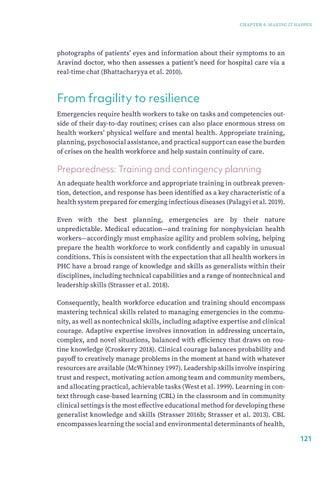CHAPTER 4: MAKING IT HAPPEN
photographs of patients’ eyes and information about their symptoms to an Aravind doctor, who then assesses a patient’s need for hospital care via a real-time chat (Bhattacharyya et al. 2010).
From fragility to resilience Emergencies require health workers to take on tasks and competencies outside of their day-to-day routines; crises can also place enormous stress on health workers’ physical welfare and mental health. Appropriate training, planning, psychosocial assistance, and practical support can ease the burden of crises on the health workforce and help sustain continuity of care.
Preparedness: Training and contingency planning An adequate health workforce and appropriate training in outbreak prevention, detection, and response has been identified as a key characteristic of a health system prepared for emerging infectious diseases (Palagyi et al. 2019). Eve n with the be st planning, e me rge ncie s are by the ir nature unpredictable. Medical education—and training for nonphysician health workers—accordingly must emphasize agility and problem solving, helping prepare the health workforce to work confidently and capably in unusual conditions. This is consistent with the expectation that all health workers in PHC have a broad range of knowledge and skills as generalists within their disciplines, including technical capabilities and a range of nontechnical and leadership skills (Strasser et al. 2018). Consequently, health workforce education and training should encompass mastering technical skills related to managing emergencies in the community, as well as nontechnical skills, including adaptive expertise and clinical courage. Adaptive expertise involves innovation in addressing uncertain, complex, and novel situations, balanced with efficiency that draws on routine knowledge (Croskerry 2018). Clinical courage balances probability and payoff to creatively manage problems in the moment at hand with whatever resources are available (McWhinney 1997). Leadership skills involve inspiring trust and respect, motivating action among team and community members, and allocating practical, achievable tasks (West et al. 1999). Learning in context through case-based learning (CBL) in the classroom and in community clinical settings is the most effective educational method for developing these generalist knowledge and skills (Strasser 2016b; Strasser et al. 2013). CBL encompasses learning the social and environmental determinants of health, 121


